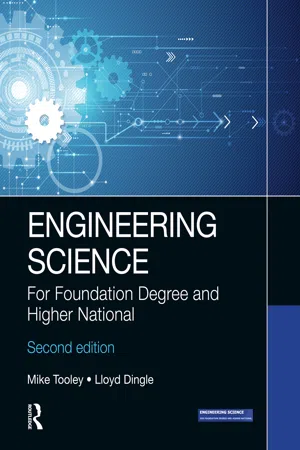
- 512 pages
- English
- ePUB (mobile friendly)
- Available on iOS & Android
About this book
Focusing primarily on core topics in mechanical and electrical science, students enrolled on a wide range of higher education engineering courses at undergraduate level will find Engineering Science, second edition, an invaluable aid to their learning.
With updated and expanded content, this new edition covers sections on the mechanics of materials, dynamics, thermodynamics, electrostatics and electromagnetic principles, and a.c./d.c. circuit theory. Entirely new sections are devoted to the study of gyroscopes and the effect of applied torques on their behaviour, and the use of Laplace transformation as a tool for modelling complex networks of inductance, capacitance and resistance. In addition, a new overview of the decibel (dB) introduces a handy technique for expressing logarithmic ratios.
Knowledge-check and review questions, along with activities, are included throughout the book, and the necessary background mathematics is integrated alongside the appropriate areas of engineering. The result is a clear and easily accessible textbook that encourages independent study and covers the essential scientific principles that students will meet at this level.
The book is supported with a companion website for students and lecturers at www.key2engineeringscience.com, and it includes:
• Solutions to the Test Your Knowledge and Review Questions in the book
• Further guidance on Essential Mathematics with introductions to vectors, vector operations, the calculus and differential equations, etc.
• An extra chapter on steam properties, cycles and plant
• Downloadable SCILAB scripts that help simplify some of the advanced mathematical content
• Selected illustrations from the book
Frequently asked questions
- Essential is ideal for learners and professionals who enjoy exploring a wide range of subjects. Access the Essential Library with 800,000+ trusted titles and best-sellers across business, personal growth, and the humanities. Includes unlimited reading time and Standard Read Aloud voice.
- Complete: Perfect for advanced learners and researchers needing full, unrestricted access. Unlock 1.4M+ books across hundreds of subjects, including academic and specialized titles. The Complete Plan also includes advanced features like Premium Read Aloud and Research Assistant.
Please note we cannot support devices running on iOS 13 and Android 7 or earlier. Learn more about using the app.
Information
Part I
Mechanics of materials
Chapter 1
Fundamentals
Table of contents
- Cover
- Half Title
- Title Page
- Copyright Page
- Contents
- Preface
- PART I Mechanics of materials
- PART II Dynamics
- PART III Thermodynamics
- PART IV Electrostatics and electromagnetism
- PART V Direct current
- PART VI Transients
- PART VII Alternating current
- Index